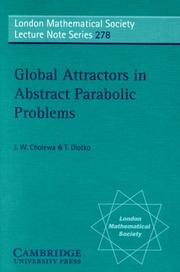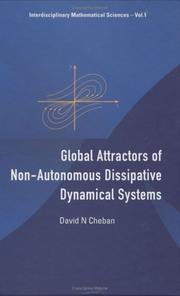| Listing 1 - 10 of 44 | << page >> |
Sort by
|
Book
ISBN: 1281789577 9786611789572 0080875467 0444890041 Year: 1992 Publisher: Amsterdam North-Holland
Abstract | Keywords | Export | Availability | Bookmark
 Loading...
Loading...Choose an application
- Reference Manager
- EndNote
- RefWorks (Direct export to RefWorks)
Problems, ideas and notions from the theory of finite-dimensional dynamical systems have penetrated deeply into the theory of infinite-dimensional systems and partial differential equations. From the standpoint of the theory of the dynamical systems, many scientists have investigated the evolutionary equations of mathematical physics. Such equations include the Navier-Stokes system, magneto-hydrodynamics equations, reaction-diffusion equations, and damped semilinear wave equations. Due to the recent efforts of many mathematicians, it has been established that the attractor of the Navier-Stokes
Book
ISBN: 9814434868 9789814434867 9789814434850 981443485X Year: 2013 Publisher: New Jersey : World Scientific,
Abstract | Keywords | Export | Availability | Bookmark
 Loading...
Loading...Choose an application
- Reference Manager
- EndNote
- RefWorks (Direct export to RefWorks)
The book surveys how chaotic behaviors can be described with topological tools and how this approach occurred in chaos theory. Some modern applications are included. The contents are mainly devoted to topology, the main field of Robert Gilmore's works in dynamical systems. They include a review on the topological analysis of chaotic dynamics, works done in the past as well as the very latest issues. Most of the contributors who published during the 90's, including the very well-known scientists Otto Rössler, René Lozi and Joan Birman, have made a significant impact on chaos theory, discrete ch

ISBN: 1139885669 1107368030 1107372550 1107363128 1107369525 1299405614 1107365570 0511526407 9781107363120 9780511526404 9781107368033 0521794242 9780521794244 Year: 2000 Volume: 278 Publisher: Cambridge Cambridge University Press
Abstract | Keywords | Export | Availability | Bookmark
 Loading...
Loading...Choose an application
- Reference Manager
- EndNote
- RefWorks (Direct export to RefWorks)
The study of dissipative equations is an area that has attracted substantial attention over many years. Much progress has been achieved using a combination of both finite dimensional and infinite dimensional techniques, and in this book the authors exploit these same ideas to investigate the asymptotic behaviour of dynamical systems corresponding to parabolic equations. In particular the theory of global attractors is presented in detail. Extensive auxiliary material and rich references make this self-contained book suitable as an introduction for graduate students, and experts from other areas, who wish to enter this field.
Attractors (Mathematics) --- Differential equations, Parabolic. --- Parabolic differential equations --- Parabolic partial differential equations --- Differential equations, Partial --- Attracting sets (Mathematics) --- Attractors of a dynamical system --- Dynamical system, Attractors of --- Sets, Attracting (Mathematics) --- Differentiable dynamical systems --- Differential equations, Parabolic
Book
ISBN: 9780511933912 9780521898058 9780511933530 0511933533 9780511928307 0511928300 9780511930836 0511930836 0511933916 1282931792 9781282931794 0521898056 1107219574 9786612931796 0511932170 0511925808 Year: 2011 Publisher: Cambridge New York Cambridge University Press
Abstract | Keywords | Export | Availability | Bookmark
 Loading...
Loading...Choose an application
- Reference Manager
- EndNote
- RefWorks (Direct export to RefWorks)
This accessible research monograph investigates how 'finite-dimensional' sets can be embedded into finite-dimensional Euclidean spaces. The first part brings together a number of abstract embedding results, and provides a unified treatment of four definitions of dimension that arise in disparate fields: Lebesgue covering dimension (from classical 'dimension theory'), Hausdorff dimension (from geometric measure theory), upper box-counting dimension (from dynamical systems), and Assouad dimension (from the theory of metric spaces). These abstract embedding results are applied in the second part of the book to the finite-dimensional global attractors that arise in certain infinite-dimensional dynamical systems, deducing practical consequences from the existence of such attractors: a version of the Takens time-delay embedding theorem valid in spatially extended systems, and a result on parametrisation by point values. This book will appeal to all researchers with an interest in dimension theory, particularly those working in dynamical systems.
Dimension theory (Topology) --- Attractors (Mathematics) --- Topological imbeddings. --- Embeddings, Topological --- Imbeddings, Topological --- Topological embeddings --- Embeddings (Mathematics) --- Attracting sets (Mathematics) --- Attractors of a dynamical system --- Dynamical system, Attractors of --- Sets, Attracting (Mathematics) --- Differentiable dynamical systems --- Topology

ISBN: 1281876720 9786611876722 9812563083 9789812563088 9789812560285 9812560289 Year: 2004 Volume: v. 1 Publisher: Hackensack, NJ : World Scientific,
Abstract | Keywords | Export | Availability | Bookmark
 Loading...
Loading...Choose an application
- Reference Manager
- EndNote
- RefWorks (Direct export to RefWorks)
The study of attractors of dynamical systems occupies an important position in the modern qualitative theory of differential equations. This engaging volume presents an authoritative overview of both autonomous and non-autonomous dynamical systems, including the global compact attractor.
Attractors (Mathematics) --- Differentiable dynamical systems. --- Differential equations. --- 517.91 Differential equations --- Differential equations --- Differential dynamical systems --- Dynamical systems, Differentiable --- Dynamics, Differentiable --- Global analysis (Mathematics) --- Topological dynamics --- Attracting sets (Mathematics) --- Attractors of a dynamical system --- Dynamical system, Attractors of --- Sets, Attracting (Mathematics) --- Differentiable dynamical systems

ISBN: 1281919454 9786611919450 9812774408 9789812774408 9789812566331 9812566333 9781281919458 6611919457 Year: 2006 Volume: v. 56 Publisher: New Jersey World Scientific
Abstract | Keywords | Export | Availability | Bookmark
 Loading...
Loading...Choose an application
- Reference Manager
- EndNote
- RefWorks (Direct export to RefWorks)
This book is the first monograph devoted exclusively to strange nonchaotic attractors (SNA), recently discovered objects with a special kind of dynamical behavior between order and chaos in dissipative nonlinear systems under quasiperiodic driving. A historical review of the discovery and study of SNA, mathematical and physically-motivated examples, and a review of known experimental studies of SNA are presented. The main focus is on the theoretical analysis of strange nonchaotic behavior by means of different tools of nonlinear dynamics and statistical physics (bifurcation analysis, Lyapunov
Attractors (Mathematics) --- Chaotic behavior in systems. --- Differentiable dynamical systems. --- Nonlinear systems. --- Systems, Nonlinear --- System theory --- Differential dynamical systems --- Dynamical systems, Differentiable --- Dynamics, Differentiable --- Differential equations --- Global analysis (Mathematics) --- Topological dynamics --- Chaos in systems --- Chaos theory --- Chaotic motion in systems --- Differentiable dynamical systems --- Dynamics --- Nonlinear theories --- Attracting sets (Mathematics) --- Attractors of a dynamical system --- Dynamical system, Attractors of --- Sets, Attracting (Mathematics)
Book
ISBN: 9814619833 9789814619837 9789814619820 9814619825 Year: 2015 Publisher: New Jersey : World Scientific,
Abstract | Keywords | Export | Availability | Bookmark
 Loading...
Loading...Choose an application
- Reference Manager
- EndNote
- RefWorks (Direct export to RefWorks)
The study of attractors of dynamical systems occupies an important position in the modern qualitative theory of differential equations. This engaging volume presents an authoritative overview of both autonomous and non-autonomous dynamical systems, including the global compact attractor. From an in-depth introduction to the different types of dissipativity and attraction, the book takes a comprehensive look at the connections between them, and critically discusses applications of general results to different classes of differential equations. The new Chapters 15–17 added to this edition include some results concerning Control Dynamical Systems - the global attractors, asymptotic stability of switched systems, absolute asymptotic stability of differential/difference equations and inclusions - published in the works of author in recent years.
Attractors (Mathematics) --- Differentiable dynamical systems. --- Differential equations. --- 517.91 Differential equations --- Differential equations --- Differential dynamical systems --- Dynamical systems, Differentiable --- Dynamics, Differentiable --- Global analysis (Mathematics) --- Topological dynamics --- Attracting sets (Mathematics) --- Attractors of a dynamical system --- Dynamical system, Attractors of --- Sets, Attracting (Mathematics) --- Differentiable dynamical systems
Book
ISBN: 3110531712 3110533022 9783110533026 9783110533033 3110533030 311053147X Year: 2017 Publisher: Berlin Boston
Abstract | Keywords | Export | Availability | Bookmark
 Loading...
Loading...Choose an application
- Reference Manager
- EndNote
- RefWorks (Direct export to RefWorks)
This unique book's subject is meanders (connected, oriented, non-self-intersecting planar curves intersecting the horizontal line transversely) in the context of dynamical systems. By interpreting the transverse intersection points as vertices and the arches arising from these curves as directed edges, meanders are introduced from the graphtheoretical perspective. Supplementing the rigorous results, mathematical methods, constructions, and examples of meanders with a large number of insightful figures, issues such as connectivity and the number of connected components of meanders are studied in detail with the aid of collapse and multiple collapse, forks, and chambers. Moreover, the author introduces a large class of Morse meanders by utilizing the right and left one-shift maps, and presents connections to Sturm global attractors, seaweed and Frobenius Lie algebras, and the classical Yang-Baxter equation. Contents Seaweed Meanders Meanders Morse Meanders and Sturm Global Attractors Right and Left One-Shifts Connection Graphs of Type I, II, III and IV Meanders and the Temperley-Lieb Algebra Representations of Seaweed Lie Algebras CYBE and Seaweed Meanders
Curves, Algebraic. --- Attractors (Mathematics) --- Lie algebras. --- Yang-Baxter equation. --- Baxter-Yang equation --- Factorization equation --- Star-triangle relation --- Triangle equation --- Mathematical physics --- Quantum field theory --- Algebras, Lie --- Algebra, Abstract --- Algebras, Linear --- Lie groups --- Attracting sets (Mathematics) --- Attractors of a dynamical system --- Dynamical system, Attractors of --- Sets, Attracting (Mathematics) --- Differentiable dynamical systems --- Algebraic curves --- Algebraic varieties
Book
ISBN: 3110298376 3110389142 3110298368 3110298295 Year: 2014 Publisher: De Gruyter
Abstract | Keywords | Export | Availability | Bookmark
 Loading...
Loading...Choose an application
- Reference Manager
- EndNote
- RefWorks (Direct export to RefWorks)
In 2008, November 23-28, the workshop of "Classical Problems on Planar Polynomial Vector Fields " was held in the Banff International Research Station, Canada. Called "classical problems", it was concerned with the following: (1) Problems on integrability of planar polynomial vector fields. (2) The problem of the center stated by Poincaré for real polynomial differential systems, which asks us to recognize when a planar vector field defined by polynomials of degree at most n possesses a singularity which is a center. (3) Global geometry of specific classes of planar polynomial vector fields. (4) Hilbert's 16th problem. These problems had been posed more than 110 years ago. Therefore, they are called "classical problems" in the studies of the theory of dynamical systems. The qualitative theory and stability theory of differential equations, created by Poincaré and Lyapunov at the end of the 19th century, had major developments as two branches of the theory of dynamical systems during the 20th century. As a part of the basic theory of nonlinear science, it is one of the very active areas in the new millennium. This book presents in an elementary way the recent significant developments in the qualitative theory of planar dynamical systems. The subjects are covered as follows: the studies of center and isochronous center problems, multiple Hopf bifurcations and local and global bifurcations of the equivariant planar vector fields which concern with Hilbert's 16th problem. The book is intended for graduate students, post-doctors and researchers in dynamical systems. For all engineers who are interested in the theory of dynamical systems, it is also a reasonable reference. It requires a minimum background of a one-year course on nonlinear differential equations.
Dynamics. --- Differential equations. --- 517.91 Differential equations --- Differential equations --- Dynamical systems --- Kinetics --- Mathematics --- Mechanics, Analytic --- Force and energy --- Mechanics --- Physics --- Statics --- Center and isochronous center. --- Hilbert's 16th problem. --- Limit cycle. --- Multiple Hopf and global bifurcations. --- Planar dynamical system.

ISSN: 00659266 ISBN: 0821807838 Year: 1998 Publisher: Providence, R.I. American Mathematical Society
Abstract | Keywords | Export | Availability | Bookmark
 Loading...
Loading...Choose an application
- Reference Manager
- EndNote
- RefWorks (Direct export to RefWorks)
Mathematical control systems --- Attractors (Mathematics) --- Attracteurs (mathématiques) --- Differentiable dynamical systems. --- Dynamique différentiable. --- Feedback control systems. --- Systèmes à réaction. --- Differentiable dynamical systems --- Feedback control systems --- Feedback mechanisms --- Feedback systems --- Automatic control --- Automation --- Discrete-time systems --- Adaptive control systems --- Feedforward control systems --- Differential dynamical systems --- Dynamical systems, Differentiable --- Dynamics, Differentiable --- Differential equations --- Global analysis (Mathematics) --- Topological dynamics --- Attracting sets (Mathematics) --- Attractors of a dynamical system --- Dynamical system, Attractors of --- Sets, Attracting (Mathematics)
| Listing 1 - 10 of 44 | << page >> |
Sort by
|

 Search
Search Feedback
Feedback About UniCat
About UniCat  Help
Help News
News